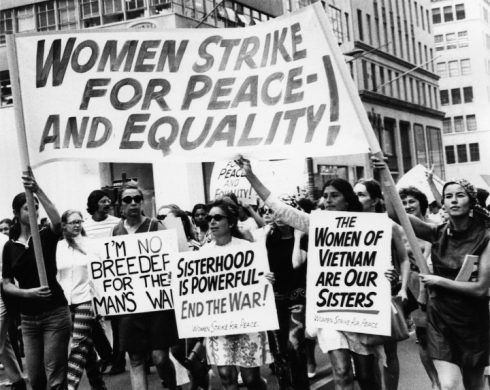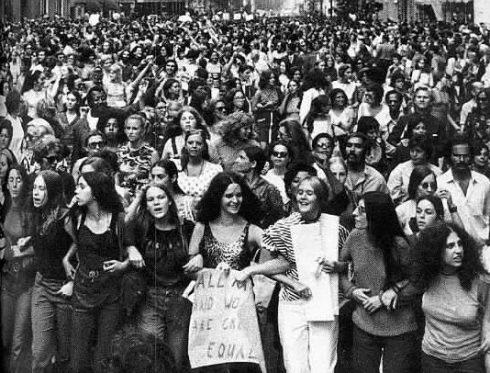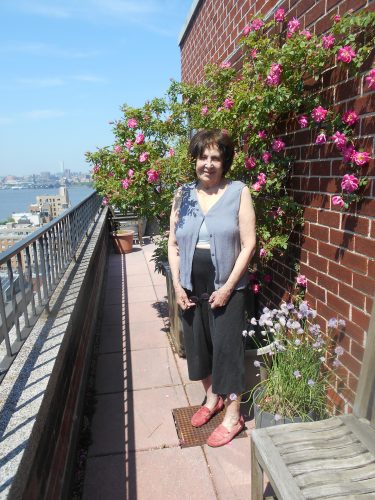Susan Brownmiller, Kate Millett and Other Prominent Second Wave Feminists will speak out against Trumpism at June 10 Reunion in Greenwich Village


Women’s Strike for Peace-And Equality, Women’s Strike for Equality, Fifth Avenue, New York, New York, August 26, 1970. (Photo by Eugene Gordon/The New York Historical Society/Getty Images)
By Mary Reinholz
Radical feminist Susan Brownmiller has plenty of room at the top in her Greenwich Village penthouse near the meat packing district. Outside on the terrace is her urban oasis of carefully cultivated plants, trees and flowers, the subject of her latest book, “My City Highrise Garden” (Rutgers University Press). To a casual observer, she appears to lead an idyllic existence in lower Manhattan.
But Brownmiller, a self-described “82-year-old celibate heterosexual,” isn’t always at peace in her spacious 20th floor pad (now shared with a roommate). It’s a rent stabilized unit which she rented at triple the cost in her Jane Street building several years after the 1975 success of her groundbreaking treatise on rape: “Against Our Will,” a tome that established her as a prominent voice in the women’s liberation movement even while some leftwing feminists denounced her for becoming a star name in a collective effort to achieve gender equality.
During a recent interview, Brownmiller recalled bitter “in-fighting” in the women’s movement. She also expressed serious concern about rightwing attacks on core feminist issues like abortion access in the Trump era when this reporter asked her about what she planned to talk about at a June 10 reunion of Second Wave feminists at Judson Memorial Church near Washington Square Park.
“I’m still working on it. I would imagine (older feminists) are feeling pretty defeated because Trump is in the White House,” Brownmiller mused as she sipped coffee and smoked Marlboros at her dining room table. “Aims that we thought we had won, we’ve lost–like abortion rights in state after state.” She noted that there’s also fear among feminists “on what Trump will do with his appointment of judges. We have every reason to be depressed.”
The reunion, a “speak-out” sponsored by Veteran Feminists of America, will bring together other well known movement activists from the late 1960s, among them social justice organizer Heather Booth, filmmaker Mary Dore; “Sexual Politics” author Kate Millett and attorney/author Jo Freeman. Guests will pay $50 each–$25 for students”–to attend the get together. There will also be women’s music by Holly Near and Margie Adam, a light lunch and refreshments plus a free gift CD of movement photographs..
The theme is “We Won’t Go Back!” a decidedly defiant slogan that will also be displayed on the red t-shirts of about 14 volunteers on hand for the occasion, according to Barbara J. Love, co-chair of the reunion and vice president of development for VFA. She edited the 2006 book listing, “Feminists Who Changed America, 1963-1975,” and co-authored the 1977 volume, “Sappho Was A Right-On Woman: A Liberated View of Lesbianism” with Sidney Abbott. Love, 80, said she will start off the program by welcoming people and making a statement before turning over the mic to attendees.
“We’re not going to go back to the 1950’s–we’re not going to let Trump do that,” she told me during a phone conversation. “People who are younger than 60 don’t remember women dying in seedy motel rooms ” from botched abortions or “being accused of attracting” rapists.
Love said the average age of second wave feminists is about 80 and predicted that some will arrive at Judson gripping walkers and seated in wheelchairs. “We’ve lost a lot of people” from the women’s movement who have died, she continued. “We’re going to have posters on the walls to remember them.” She also hopes to attract young women–and men–to the VFA reunion, claiming there’s a “resurgence and excitement among younger women because of Trumpism. I think young people realize what they could lose. A lot of them went to Washington” for the women’s march a day after Trump’s inauguration. “Some went to Boston and to Mar-a-lago. I went to the march in New York. There were thousands of young people there.”
Carol DeSaram, a board member of VFA and a former New York City chapter president of the National Organization for Women in the 1970s, believes younger women will continue to protest any Trump attempts to roll back feminist gains and .said reports of the movement’s demise are greatly exaggerated. “No way– It’s just the opposite,” she said. “I get emails every weekend out of the New York City NOW chapter about people showing up for demonstrations. They’ve been to big ones. There was one in front of Trump Tower. This has happened because there’s this surge by young people who are not affected by the past and are incensed because their rights are being threatened. They’re coming out in droves. They want action, not a lecture.”
“Everybody is depressed,” noted DeSaram, a 78-year-old grandmother of five and former member of the Tribeca Community Association who now lives with her husband in Rhinebeck.”Young people always assumed they had these rights, so how dare this Neanderthal sexist pig try to take them away?”
DeSaram was unable to attend the recent women’s march in January. But she was part of the historic August 26,1970 Women’s Strike for Peace and Equality, a massive march down Fifth Avenue in Manhattan organized by NOW and inspiring smaller demonstrations in cities across the country. She was at the forefront of the feminist battle to end credit card discrimination against women who had been unable to get an open line to credit in their own names without the approval of their husbands or fathers. DeSaram and other NOW members attended public hearings and read anguished letters from divorced and destitute women in Congress. In 1974, Congress passed passed the Equal Credit Opportunity Act outlawing the discriminatory practice.
Brownmiller, who joined the recent march against Trumpism in New York, is not so sure that young women these days recognize the contributions of older feminists— which include NOW’s successful lobbying back in 1968 to turn the men and women want ads into gender neutral listings. ” I know the times have changed. But I get really angry when women on the college campuses think they’ve discovered rape,” she said. “Abortion rights was our victory–also all the violence issues: rape and sexual assaults and assaults of children.”
Gloria Steinem, a co-founder of Ms. Magazine, surfaced as a feminist leader several years after radical feminist groups like Redstockings held speak-outs and created conscious raising. One of its leaders, Kathie Sarachild, coined the phrase: “Sisterhood is powerful.” In 1968, New York Radical Women demonstrated against the Miss America beauty pageant in Atlantic City, N.J, tossing girdles, bras and copies of Playboy into “freedom trash cans.”. Yet Steinem is often regarded in the media as the “face” of the women’s movement, a label disputed by Redstockings and by Steinem herself. How does Brownmiller view her?
“It is our custom–certainly in America–that the media picks one person.as the icon of an entire movement,” she replied with some irony. “When we had those (recent) marches in New York, Washington D.C. and around the world, I happened to be watching (cable) and Chris Matthews” on MSNBC. “He devoted about 10 seconds to this phenomenon and said, ‘Women marched all over the world today.’ Then he ran a picture of Gloria and said, ‘Isn’t she wonderful?””
Brownmiller, however, acknowledges that that the still beautiful and articulate Steinem, now 83, made the women’s movement palatable to mainstream America. “We were caricatured as angry women in combat boots. Gloria, God bless her, would never get angry. It was remarkable.”
Betty Friedan,the feisty co-founder of NOW and its first president, was undoubtedly a primary force in the nascent women’s movement after she wrote her first book, “The Feminine Mystique” in 1963 about educated suburban housewives trapped in domesticity. It’s widely credited with influencing second wave feminism in the U.S. during the 20th century even though, as Brownmiller noted, Friedan was “a little slow in recognizing that there were a lot of lesbians in the women’s movement.”
Indeed, Friedan dubbed lesbians in the movement as “infiltrators,” “blackmailers” and “seducers” in a 1973 retrospective, claimed Love, who noted, “She mellowed and finally accepted reality.” Friedan and other ghosts of the feminist past may get channeled at Judson on June 10, and that could be a lively experience for second wave feminists. “We don’t get together that often except at funerals,” Love said.

Comments
Leave a Reply
You must be logged in to post a comment.



